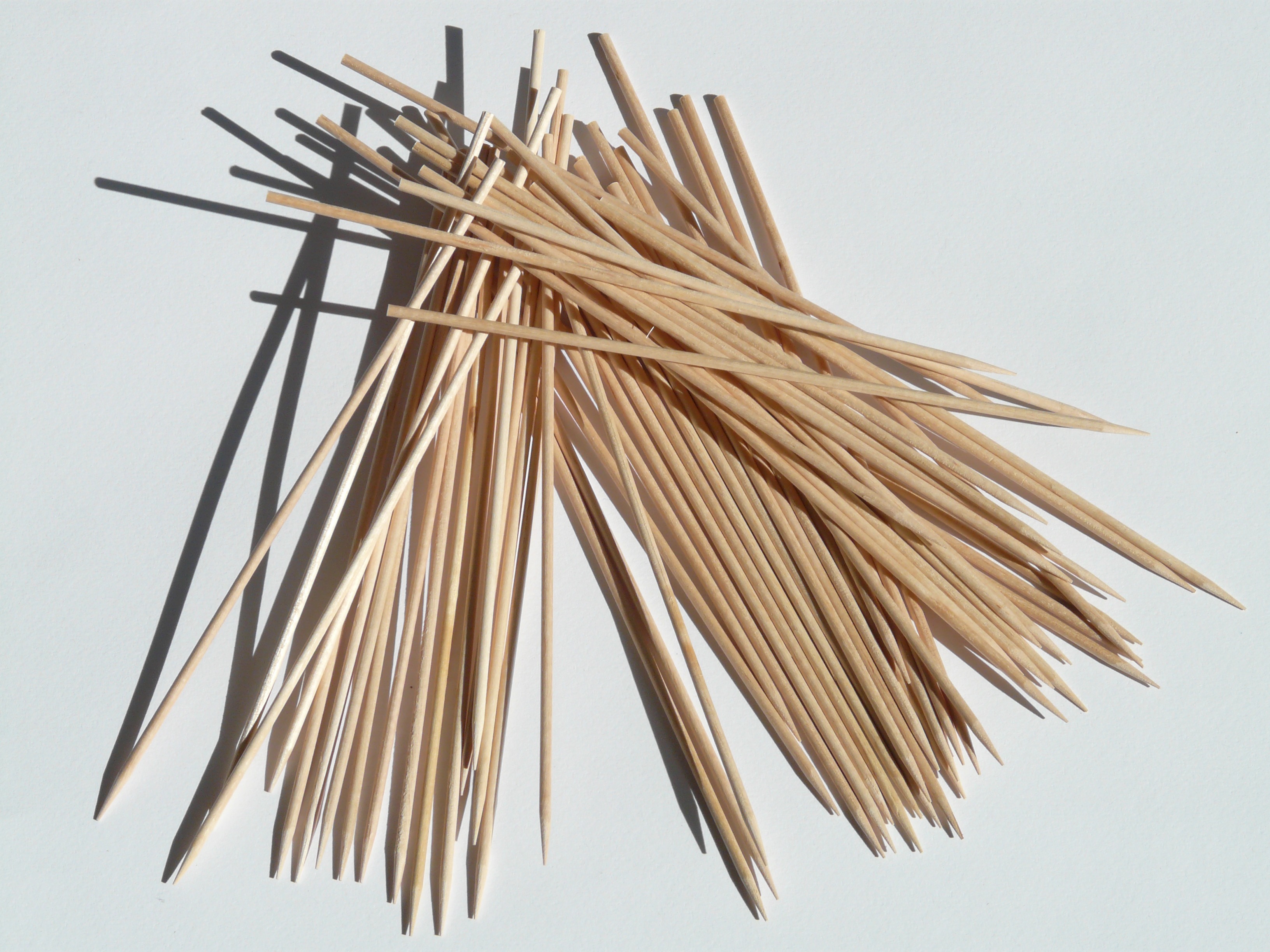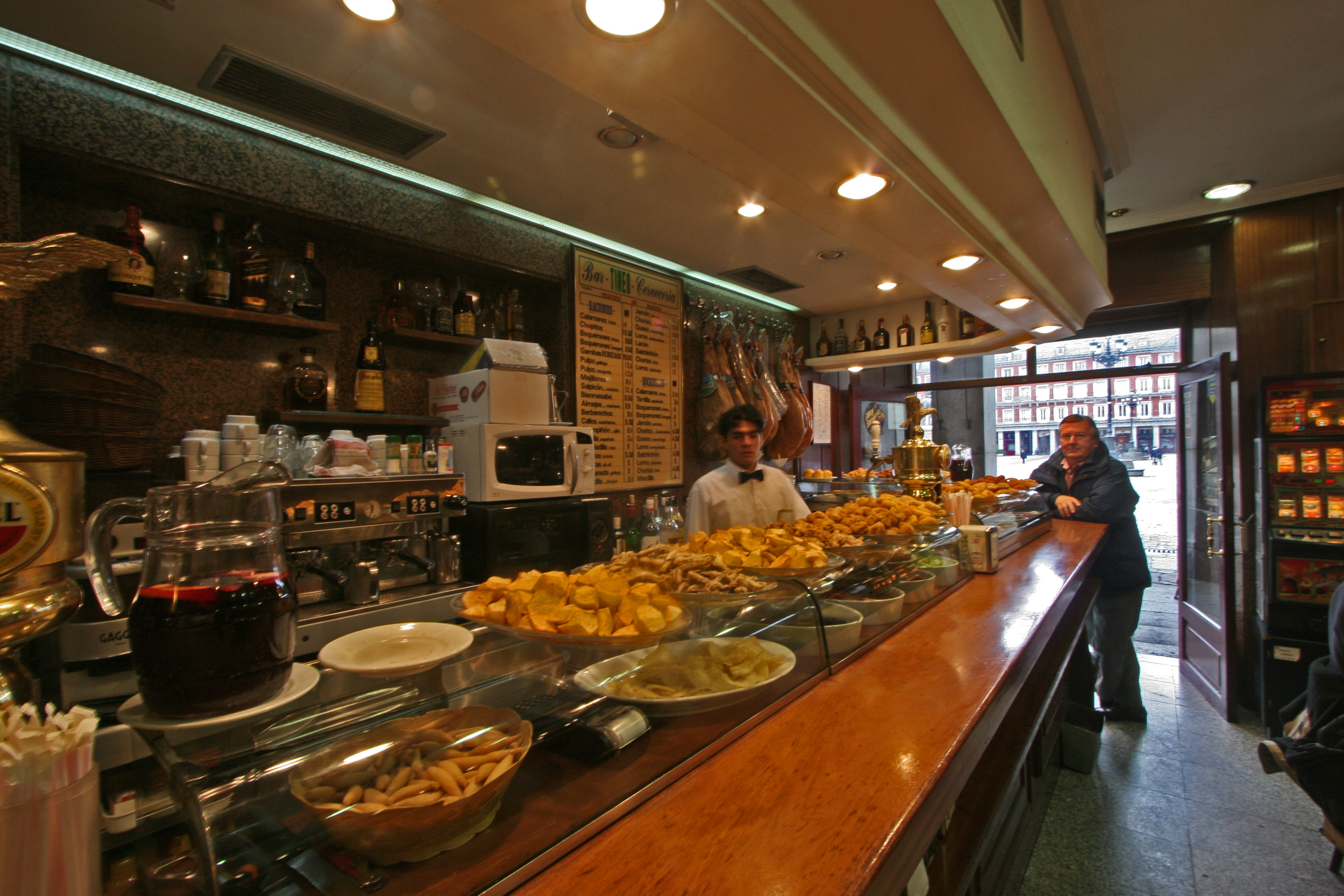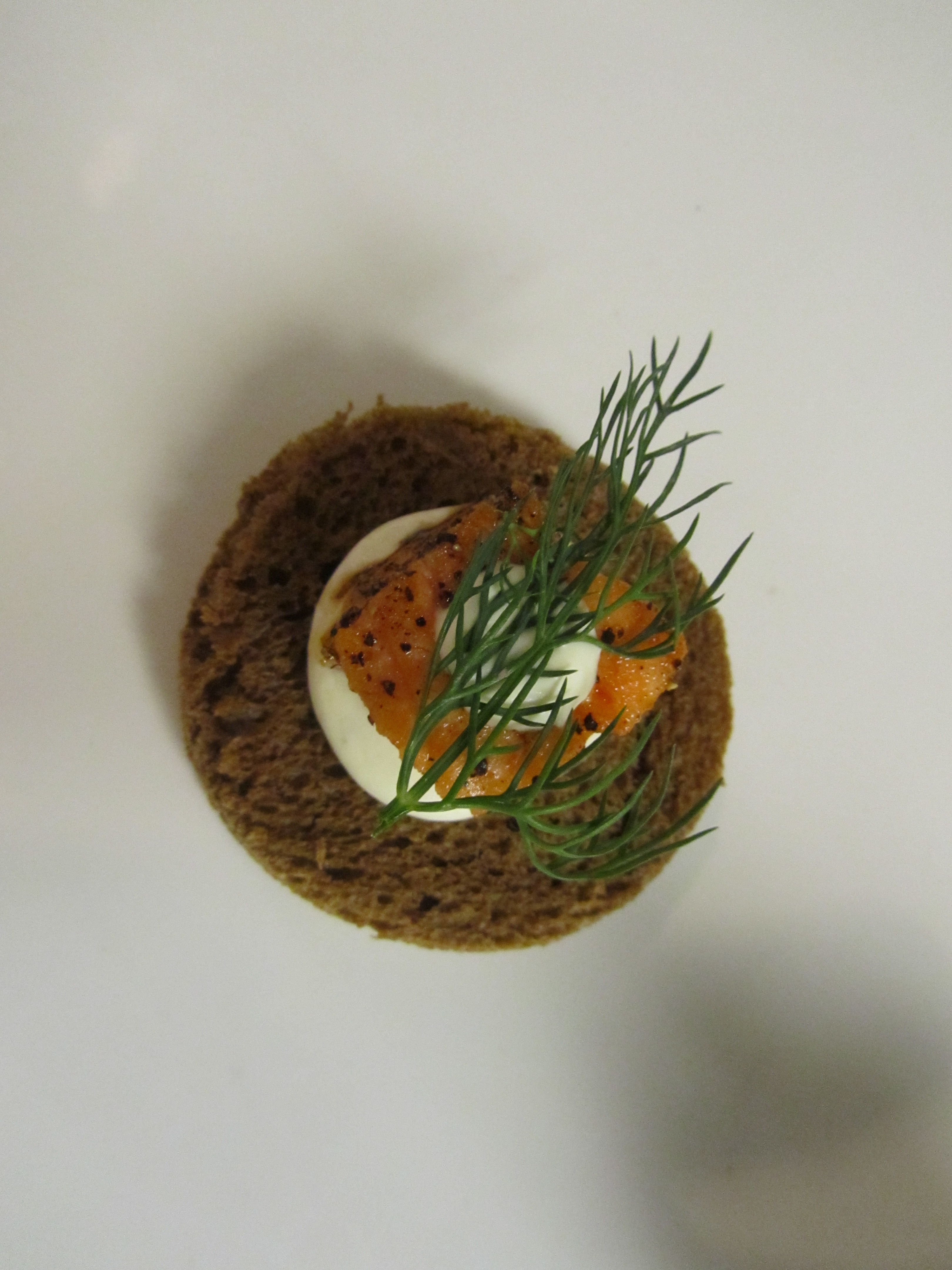|
Pintxo
A pincho (; literally "thorn" or "spike"), pintxo () or pinchu () is a small snack, typically eaten in bars, traditional in northern Spain and especially popular in the Basque country, Navarre, La Rioja, Cantabria, and Asturias. They are usually eaten in bars or taverns as a small snack while hanging out with friends or relatives; thus, they have a strong socializing component, and in the Basque country and Navarre, they are usually regarded as a cornerstone of local culture and society. They are related to tapas, the main difference being that pinchos are usually 'spiked' with a skewer or toothpick, often to a piece of bread. They are served in individual portions and always ordered and paid for independently from the drinks. It is not impossible, however, to have the same " pincho " item in one place and "tapa" in another. They are called ''pinchos'' because many of them have a ''pincho'' (Spanish for ''spike''), typically a toothpick —or a skewer for the larger varieties— ... [...More Info...] [...Related Items...] OR: [Wikipedia] [Google] [Baidu] |
Basque Country (autonomous Community)
The Basque Country (; eu, Euskadi ; es, País Vasco ), also called Basque Autonomous Community ( eu, Euskal Autonomia Erkidegoa, links=no, EAE; es, Comunidad Autónoma del País Vasco, links=no, CAPV), is an Autonomous communities of Spain, autonomous community of Spain. It includes the Provinces of Spain, provinces (and historical territories) of Álava, Biscay, and Gipuzkoa, located in the north of the Iberian Peninsula, bordering on the autonomous communities of Cantabria, Castile and León, La Rioja (Spain), La Rioja, and Navarre, and the Regions of France, French region of Nouvelle-Aquitaine. The Basque Country or Basque Autonomous Community is enshrined as a 'Nationalities and regions of Spain, nationality' within the Spanish State in Statute of Autonomy of the Basque Country, its 1979 statute of autonomy, pursuant to the administrative acquis laid out in the Spanish Constitution of 1978, 1978 Spanish Constitution. The statute provides the legal framework for the develop ... [...More Info...] [...Related Items...] OR: [Wikipedia] [Google] [Baidu] |
Bermeo
Bermeo is a town and municipality in the ''comarca'' of Busturialdea. It is in the province of Biscay, which is part of the autonomous region of the Basque Country in northern Spain. With a population of 16,765, it is the most important fishing port in the Basque Country. The town was founded in 1236, and is the largest in Busturialdea. Bermeo was the provincial capital of Biscay from 1476 to 1602. Tourist attractions include the island of Gaztelugatxe, the Ercilla Tower (a fishing museum), San Juan Gate and the port. Bermeo is connected by Euskotren Trena and BizkaiBus to Bilbao. It has a number of neighbourhoods: Arana, Artike, Agirre, San Andres, Almike, Arronategi, San Migel, Demiku, Mañu and San Pelaio. History Bermeo's history dates back to the monastery of San Juan of Gaztelugatxe in 1051. In 1082, it is mentioned by Don Lope lñiguez as "Sancti Michaelis Arcangeli in Portu of Vermelio". Ferdinand II of Aragon named the town the capital of Biscay on 31 July 1476, a po ... [...More Info...] [...Related Items...] OR: [Wikipedia] [Google] [Baidu] |
Tavern
A tavern is a place of business where people gather to drink alcoholic beverages and be served food such as different types of roast meats and cheese, and (mostly historically) where travelers would receive lodging. An inn is a tavern that has a license to put up guests as lodgers. The word derives from the Latin ''taberna'' whose original meaning was a shed, workshop, stall, or pub. Over time, the words "tavern" and "inn" became interchangeable and synonymous. In England, inns started to be referred to as public houses or pubs and the term became standard for all drinking houses. Europe France From at least the 14th century, taverns, along with inns and later cabarets, were the main places to dine out. Typically, a tavern offered various roast meats, as well as simple foods like bread, cheese, herring and bacon. Some offered a richer variety of foods, though it would be cabarets and later ''traiteurs'' which offered the finest meals before the restaurant appeared in the 1 ... [...More Info...] [...Related Items...] OR: [Wikipedia] [Google] [Baidu] |
Brochette
A skewer is a thin metal or wood stick used to hold pieces of food together. The word may sometimes be used as a metonym, to refer to the entire food item served on a skewer, as in "chicken skewers". Skewers are used while grilling or roasting meats and fish, and in other culinary applications. In English, brochette is a borrowing of the French word for skewer. In cookery, ''en brochette'' means 'on a skewer', and describes the form of a dish or the method of cooking and serving pieces of food, especially grilled meat or seafood, on skewers; for example "lamb cubes en brochette". Skewers are often used in a variety of kebab dishes. Utensil Metal skewers are typically stainless steel rods with a pointed tip on one end and a grip of some kind on the other end for ease of removing the food. Non-metallic skewers are often made from bamboo, as well as hardwoods such as birch, beech, or other suitable wood. Prior to grilling, wooden skewers may be soaked in water to avoid bu ... [...More Info...] [...Related Items...] OR: [Wikipedia] [Google] [Baidu] |
Yakitori
is a Japanese type of skewered chicken. Its preparation involves skewering the meat with , a type of skewer typically made of steel, bamboo, or similar materials. Afterwards, they are grilled over a charcoal fire. During or after cooking, the meat is typically seasoned with tare sauce or salt. The term is sometimes used informally for ''kushiyaki'' (grilled and skewered foods) in general. Preparation As they are designed for convenience and portability, yakitori are typically cooked using step-by-step methods. Traditionally, it was accomplished using portable charcoal grills. That is the method most often employed by yatai, however, restaurants may use stationary grills and, depending on the situation, higher quality binchōtan charcoal. At home, appliances known as or are used. Yakitori-ki are small electrical appliances that use a heating element similar to that of a broiler or toaster to cook the food placed on top. To facilitate even cooking, the meat is cut into s ... [...More Info...] [...Related Items...] OR: [Wikipedia] [Google] [Baidu] |
Mixed Grill
Many regional cuisines feature a mixed grill, a meal consisting of a traditional assortment of grilled meats. List of mixed grill dishes Mixed grill dishes include: * ''Churrasco'' – typically featuring various cuts of chicken and beef, especially chicken hearts and ''picanha'' (rump cover). * Fatányéros – a traditional Hungarian mixed grill barbecue dish * Jerusalem mixed grill (''Me'orav Yerushalmi''; מעורב ירושלמי), contains chicken hearts, livers, spleen and bits of lamb grilled with onion, garlic and an array of Middle Eastern spices. * * * |
Pinchitos
Pinchitos or Pinchos Morunos is a Moorish-derived food in Spanish cuisine, similar to kebab. The name ''pinchitos'' is used in the southern Spanish autonomous communities of Andalusia and Extremadura. They consist of small cubes of meat threaded onto a skewer ( es, pincho) which are traditionally cooked over charcoal braziers. Similar dishes in North Africa or other Muslim majority countries tend to be lamb based, but pork and chicken are the most popular meats for the dish in Spain. In other countries Puerto Rico In Puerto Rico they are called pinchos and they are so popular that they are almost considered as a traditional dish. Unlike other countries, pinchos are made throughout the year. Pinchos are sold basically everywhere on the island of Puerto Rico, but mainly in food trucks or markets around the beach and the old town. Pinchos can be made with different kinds of meat (pork being the most famous one); however, they are also made with chicken and shark meat. They ... [...More Info...] [...Related Items...] OR: [Wikipedia] [Google] [Baidu] |
Tapas
A tapa () is an appetizer or snack in Spanish cuisine. Tapas can be combined to make a full meal, and can be cold (such as mixed olives and cheese) or hot (such as ''chopitos'', which are battered, fried baby squid, or patatas bravas). In some bars and restaurants in Spain and across the globe, tapas have evolved into a very sophisticated cuisine. In some Central American countries, such snacks are known as ''bocas''. In parts of Mexico, similar dishes are called ''botanas''. History The word "tapas" is derived from the Spanish verb ''tapar'', "to cover", a cognate of the English ''top''. In pre-19th-century Spain tapas were served by ''posadas'', ''albergues'' or ''bodegas'', offering meals and rooms for travellers. Since few innkeepers could write and few travellers read, inns offered their guests a sample of the dishes available, on a "tapa" (the word for pot cover in Spanish). According to ''Joy of Cooking'', the original tapas were thin slices of bread or meat wh ... [...More Info...] [...Related Items...] OR: [Wikipedia] [Google] [Baidu] |
Canapé
A canapé () is a type of hors d'oeuvre, a small, prepared, and often decorative food, consisting of a small piece of bread (sometimes toasted) wrapped or topped with some savoury food, held in the fingers and often eaten in one bite. Name The name comes from the French word for sofa, drawing on the analogy that the garnish sits atop the bread as people do on a couch. Details Because they are often served during cocktail hours, it is often desired that a canapé be either salty or spicy, in order to encourage guests to drink more. A canapé may also be referred to as finger food, although not all finger foods are ''canapés''. Crackers or small slices of bread or toast or puff pastry are cut into various shapes, used as the base for savory butters or pastes, and often topped with other savory foods such as meat, cheese, fish, caviar, ''foie gras'', purées or relish. Traditionally, ''canapés'' are built on stale bread (although other foods such as puff pastry, crackers ... [...More Info...] [...Related Items...] OR: [Wikipedia] [Google] [Baidu] |
Croquette
A croquette is a deep-fried roll consisting of a thick binder combined with a filling, which is breaded and deep-fried; it is served as a side dish, a snack, or fast food worldwide. The binder is typically a thick béchamel or brown sauce, mashed potatoes, wheat flour or wheat bread. The binder may be mixed with or stuffed with a filling; this mixture is called a ''salpicon''. Typical fillings include finely chopped meat, seafood, cheese, rice, pasta, mushrooms, as well as various vegetables as well as seasonings such as herbs and spices. Sweet croquettes may use a pastry cream binder and be filled with fruit. Croquettes may also be formed in other shapes: disks, ovals, balls. Etymology The word ''croquette'' is French, derived from ''croquer'', meaning 'to crunch'. In the 18th century, it was typically spelled ''croquet''. Alan Davidson, ''Oxford Companion to Food'', 1999, ''s.v.'', p. 229 Origins A 17th-century recipe for croquettes (''croquets'') by François Massialot ... [...More Info...] [...Related Items...] OR: [Wikipedia] [Google] [Baidu] |
Capsicum
''Capsicum'' () is a genus of flowering plants in the Solanum, nightshade family Solanaceae, native to Americas, the Americas, cultivated worldwide for their chili pepper or bell pepper fruit. Etymology and names The generic name may come from Latin language, Latin , meaning 'box', presumably alluding to the pods; or possibly from the Greek language, Greek word , 'to gulp'. The name "pepper" comes from the similarity of piquance (spiciness or "heat") of the flavor to that of black pepper, ''Piper (genus), Piper nigrum'', although there is no botanical relationship with it or with Sichuan pepper. The original term, ''chilli'' (now ''chile'' in Mexico) came from the Nahuatl word ''chīlli'', denoting a larger ''Capsicum'' variety Mesoamerican agriculture, cultivated at least since 3000 BC, as evidenced by remains found in pottery from Puebla and Oaxaca. Different varieties were cultivated in South America, where they are known as ''ajíes'' (singular ''ají''), from the Quechu ... [...More Info...] [...Related Items...] OR: [Wikipedia] [Google] [Baidu] |
Tortilla De Patatas
Spanish omelette or Spanish tortilla is a traditional dish from Spain. Celebrated as a national dish by Spaniards, it is an essential part of the Spanish cuisine. It is an omelette made with eggs and potatoes, optionally including onion. It is often served at room temperature as a tapa. It is commonly known in Spanish-speaking countries as , , or . History The first reference to the tortilla in Spanish is found in a Navarrese document, as an anonymous "mousehole memorial" addressed to the court of Navarre in 1817. It explains the sparse conditions of Navarre's farmers in contrast with those in Pamplona (the capital) and la Ribera (in southern Navarre). After listing the sparse food eaten by highlanders, the next quote follows: "…two to three eggs in tortilla for 5 or 6 eopleas our women know how to make it big and thick with fewer eggs, mixing potatoes, breadcrumbs or whatever." According to legend, during the siege of Bilbao, Carlist general Tomás de Zumalacárregui inv ... [...More Info...] [...Related Items...] OR: [Wikipedia] [Google] [Baidu] |








.jpg)